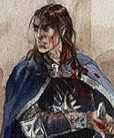Aragorn by Figwit
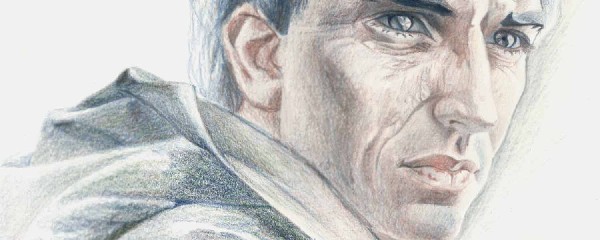
Who is Aragorn in ‘The Two Towers’?
When we enter ‘The Two Towers’, Aragorn is still the same guy he was when we left ‘Fellowship of the Ring’: he is leading the slightly reduced remainder of the Fellowship across the grass plains of Rohan, occasionally stooping to examine said grass for traces of Merry, Pippin or a stampede of Uruks.
‘The Two Towers’, however, sees Aragorn struggle with his heritage, his place within society and the burden of his relationship with Arwen. I will discuss these three aspects of the Aragorn-story-arc seperately.
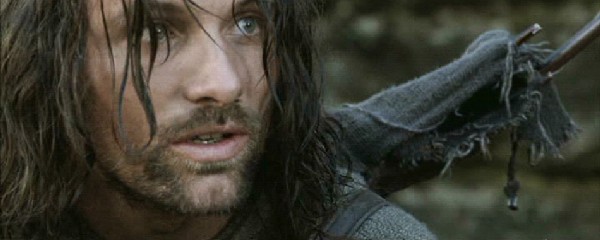
1. From Strider to Elessar
In the books, Aragorn is probably one of the few flat characters walking on the foreground of the story. The reason for this is quite simple: Aragorn is really old, and his struggle with his destiny and his heritage is long over. The Aragorn we meet in the books, from the moment we are introduced to his Strider-persona in a shady inn in Bree, is nothing less than the King of Men.
The scriptwriters chose to add more depth to Aragorn’s story by showing the slow transition from ranger to king. ‘The Two Towers’, as the centre piece of the trilogy, has to play a crucial role in this transition. Roughly, the movie falls apart in three different parts:
Tracker
In the first half of the movie, Aragorn is still the ranger-tracker we know from ‘Fellowship of the Ring’: he tracks the Uruk-hai across the plains of Rohan, he figures out what happened to Merry and Pippin and he’s not as much the ‘leader’ of the three hunters, but the ‘respected elder’ – the one with the best tracking skills obviously is the one who leads the hunt.
This is different from how Aragorn is portrayed in the first chapters of the book. Exemplary of this is his introduction of himself to Éomer: while at first he claims he is Strider … [come] out of the North… hunting orcs, after a while he threw back his cloak. The elven-sheath glittered as he grasped it, and the bright blade of Andúril shone like a sudden flame as he swept it out. ‘Elendil!’ he cried. ‘I am Aragorn son of Arathorn, and am called Elessar, the Elfstone, Dúnadan, the heir of Isildur Elendil’s son of Gondor. Here is the Sword that was Broken and is forged again! Will you aid me or thwart me? Choose swiftly!’ [3.II.]
Prince
After the company, joined by Gandalf, arrives in Edoras something changes in Aragorn’s demeanor: most of the action revolves around Théoden (in Edoras) and Éowyn (on route to Helm’s Deep) and in both cases Aragorn’s relationship to them is the focus. Still, Aragorn shows himself more as an exceptional Man, than as a Man with exceptional skills: he commands Théoden in front of his own subjects to let Gríma go, questions Théoden’s decision to go to Helm’s Deep and shows sudden horsewhispering-skills. Théoden’s bitter reply that when last I looked, Théoden, not Aragorn, was King of Rohan, only drives home the point that Aragorn ís the King of Men, and not Théoden.
Contrary to his previous behaviour with Éomer, Aragorn doesn’t impose himself on Théoden in this way in the book. At the doors of Meduseld, he does reveal himself als Elendil’s heir. After that, however, he is discretion itself. As always, he lets Gandalf discuss the important things and make the suggestions to an otherwise strong-minded Théoden. This fits the idea of a medieaval knight who knows everything about courtly behaviour and respect for people’s territories.
King
It is clear from this that Aragorn is pushed into the position of leader, but still rather reluctantly. Though the shift from ranger to king is gradual, the script writers decided Aragorn needed a little nudge – quite literally: during the fight with the Wargs, he [takes] a little tumble off the cliff. The movie sees Aragorn ‘die’, receive the ‘breath of life’ from Arwen and then ‘resurrect’ to save the day at Helm’s Deep.
The pinnacle of this transition, which is in fact only completed in the infamous scene with the Palantír in ‘The Return of the King’, is the conversation between Théoden and Aragorn in the throne chamber of the Hornburg: here, Théoden is reduced to a weak old man with no hope left, while Aragorn is promoted to a proud and fearless leader of Men, who inspires courage in his Men (as is examplified by the pep-talk he gives Haleth). Who are – point of fact – not even his Men.
Needless to say, none of this happens in the book – there, Aragorn just defends the keep alongside Théoden and Éomer, without insulting them or bossing them around. It is Aragorn who seems to loose hope, asking Théoden to remain in the keep, and it is the old Rohir who speaks of courage when hope is gone; and who ultimately decides to ride out and meet the Uruks head on.
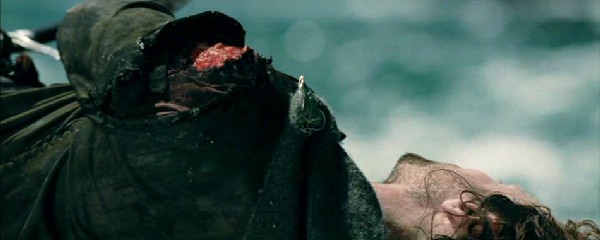
2. Between Legolas and Théoden
A second important aspect of Aragorn’s portrayal in ‘The Two Towers’ is the relationships he develops with the people around him. This should help us define the way Aragorn envisions his future position as a king – except that there’s little consistency to it.
First of all there’s the duality between Aragorn as the leader of the remainder of the Fellowship, and Aragorn as a guest in Rohan. While, as was explained above, there are good reasons why Aragorn would be the natural leader of the three hunters, this does not give him any authority to act as a leader outside this trio – which, on multiple occasions – he does.
While in the ‘Riders of Rohan’-scene, he obviously accepts Éomer as an authority figure, and treats him with a great amount of respect (more, I would say, than he does in the book); he fails to grant Théoden, who’s the King of Rohan after all, that same well-earned respect. This doesn’t keep with the book: there it’s Gandalf who stays Théoden’s hand when he wants to kill Gríma (a logical reaction coming from a Maia, but not so from a Man with no claim yet to anything), and it’s Gandalf who tries to change Théoden’s mind about the right course of action. Aragorn stays in the background throughout the entire ‘King of the Golden Hall’-chapter.
During the battle at Helm’s Deep he takes on a more active role, but never in a way that pushes Théoden off the stage. As mentioned earlier, it was Théoden who in the end breaks through the shroud of worry and doubt and rides out; and Aragorn who agrees to join him.
Another strange development in ‘The Two Towers’ is the bond that is established between Legolas and Aragorn. In ‘The Fellowship of the Ring’ there was already one scene that suggests a deeper friendship between the elf and the ranger, namely during the council of Elrond where Legolas blabs out Aragorn’s real name and position – a very non-canonical moment.
In ‘The Two Towers’, Legolas and Aragorn share a number of scenes which build on this ‘relationship’: there’s of course the scene where Legolas realises Aragorn is dead, the fact that he keeps the Evenstar with him (to return it to Arwen? or as a token of remembrance?), the fight in the armoury of the Hornburg and later on the moment of reconciliation (You have not lead us astray…), the heroic rescue of Aragorn and Gimli during the battle… All of these scene are non-canon.
It seems, maybe to get Legolas more emotionally involved, that the script writers created a friendship between Aragorn and Legolas that’s not – at least to such an extent – present in the book.
This shifts the character of Aragorn from a loner in the book, a man who keeps himself to himself – quite literally, at the beginning; to almost one half of a duo. (This tendency to team up Aragorn with Legolas continues in ‘The Return of the King’, with the much debated ‘Aragorn-despairs’ scene.)
It also jeopardises the relationship between Gimli and Legolas, which was an important part of the plot in Book 3 and mcuh loved by bookies. And, in combinationship with the also non-canonical banishment, Éomer and Aragorn don’t form an early alliance in the movies like they do in the book, where both future kings fight side by side and proclaim themselves friends and brothers in arms.
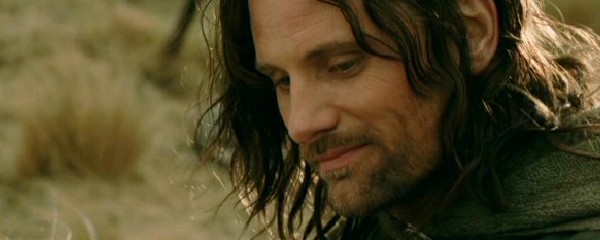
3. Aragorn and the Ladies
Finally, something needs to be said about Aragorn’s altered relationship with the women in his life.
Aragorn the Bachelor
One of the major changes to the romantic storyline of ‘The Lord of the Rings’ is the break-up between Aragorn and Arwen. In the book, there is never a moment of doubt between the two that they will reach their goal and be wed. While Arwen stays behind in Rivendell, knitting a banner of some sorts, Tolkien writes that while Aragorn was abroad, from afar she watched over him in thought. [Appendix A (vi)] About his marriage to Arwen, Aragorn says after the end of the War of the Ring: ‘A day draws near that I have looked for in all the years of my manhood…’ [6.V.]
However, the movie has Elrond – very much out of character – pressure Aragorn into letting Arwen go to the Havens and releasing her from her pledge to him. Aragorn seems persuaded by Elrond’s arguments and even wants to return the Evenstar to her, which she refuses to take back. Though this happened before the Fellowship left Rivendell, we only discover the fact of their break-up halfway through ‘The Two Towers’.
This of course places Aragorn in a position that he never has in the books: that of an eligable bachelor. Enter candidate number one…
Aragorn and Éowyn
One of the most heated debates concerning ‘The Two Towers’ revolves around the question: ‘Does Aragorn lead Éowyn on, or not?’ Though this is a very subjective matter, there are some things that could be said about it.
First of all, Aragorn is not spoken for as he was in the books. He broke off his relationship with Arwen, and so he is not bound to her as he was before. This gives him the liberty to explore whatever feelings he might develop for Éowyn.
Secondly, Éowyn is a very different character from the book: while on the page she was cold and hard, focussed on glory and escaping the dreary life of servitude in the halls of Meduseld, waiting on her uncle; movie Éowyn is a warm-blooded, feisty young woman who seems to have a lot more to offer to the likes of Aragorn, at a first glance at least.
There are of course some scenes that are open for speculation, the infamous stew-scene the most obvious one.
On the other hand, he does seem to give Éowyn some signals of disinterest: though he stresses the fact that Arwen is an Elf who returned to the Undying Lands, he keeps wearing the Evenstar openly. He also turns down her offer of fighting alongside him, and neglects to answer her open admission of love.
Forever faithful?
The question is whether Aragorn ever really considers the option of taking Éowyn as a wife. Though the filmmakers obviously want us to believe this is possible, I highly doubt it. As I said before, he openly wears the Evenstar, and we are also to believe that Aragorn let go of Arwen out of love – so we can only assume that a love that strong doesn’t just die like that.
Significantly, it’s Arwen who gives Aragorn ‘the breath of life’ after his close encounter with death in the river. Their fates still seem bound, and no evil Elrond seems to be able to come between them – not even when we are supposed to believe Arwen left for the Grey Havens. Somehow, we know that this is not the end of it.
- 2.03. The Departure from Rivendell by Figwit
- 3.01.*c. The Three Hunters by elenluin
- 3.02. The Riders of Rohan by atalante_star
- 3.05. The White Rider by Morwinyoniel
- 3.06. The King of the Golden Hall by atalante_star
- 3.06.*a. The Journey to Helm's Deep by Figwit
- 3.06.*b. Evenstar by Figwit
- 3.06.*d. Breath of Life/a> by Figwit
- 3.07. The Battle of Helm's Deep by atalante_star
- Aragorn in FOTR by atalante_star
- Arwen in TTT by Figwit
- Éowyn in TTT by Aervir
- Théoden in TTT by atalante_star
Interesting Links:
Our Character Gallery has a separate section devoted to Aragorn.
It also has the screencaps of the theatrical version, as well as the extended edition.
A transcript of 'The Lord Of the Rings: The Two Towers' can be found in our Film Fun & Facts section.
A summary of 'The Lord Of the Rings: The Two Towers' can be found in Elrond's Library.
You can also check out some pictures of Viggo Mortensen in our Cast & Crew Gallery, as well as pictures by him (here) and pictures of him and Karl Urban (here); or read a short biography in our Film, Fun & Facts section.
Some articles that are related to Aragorn:
- You can read all about Aragorn and Arwen in the Encyclopedia. It also contains information about his mother Gilraen, and his fosterfather Elrond.
- More information on Aragorn and his heritage can be found in the following articles: The Sword of Elendil by Fossegrim talks about the Shards of Narsil; A History of the Númenóreans, The Númenórean Realms in Exile and The Dúnedain of the North by Nienna-of-the-Valar; and articles on Eärendil and Arwen Undómiel (by Evenstar01). There's also a Family Tree of the Kings of Arnor and Gondor.
Forum threads related to Aragorn / Viggo Mortensen:
- Characterization of Aragorn in the Movie Forum talks about the movie character in depth.
- In the Book Forum there’s A Question About Aragorn discussing his heroic position, and Were Aragorn and Arwen related?.
- The Casting Forum has a thread devoted to Viggo Mortensen and also discusses the first casting of Stuart Townsend as Aragorn.
Take a look at how some artists saw Aragorn in The Two Towers:
- The Elven-brooch by Anke Eissmann
- The Riders of Rohan by Anke Eissmann
- Aragorn by Gwyllion
- Aragorn by John Howe
- Aragorn and Éowyn by ponine21
Preview the Aragorn Chat Skin here.
Preview the Aragorn Theme here.
Looking for something more creative - you may find it here:








